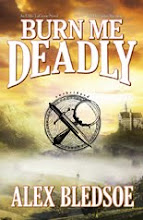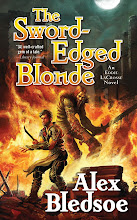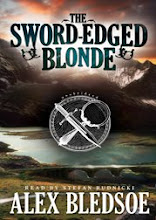Coming up with character names is, as the master Charles Dickens probably knew, one of the most fun aspects of writing. Unlike real life, where you're named long before your identity is formed, you have the chance to give someone a handle that reflects their personality. Villains can be named "Uriah Heep"; plucky young urchins can be "Pip" or "The Artful Dodger"; Doomed girls can be "Little Nell." For a current master of this sort of thing, check out the films of Larry Blamire (for example, in The Lost Skeleton of Cadavra his alien couple is named "Kro-Bar" and "Lattis.").
But sometimes naming gets...tricky. As I've said elsewhere, I first invented my Eddie LaCrosse character in high school, except back then I named him "Devaraux LaCrosse." It was my attempt to play the high-fantasy, high-falutin' name game so prevalent in the genre of the time. My villain, who ultimately bore the much more reasonable monicker "Andrew Reese," was then known as "Kakorian Shay." Now, there's nothing inherently wrong with these ten-dollar names, I suppose, and perhaps a better writer could've made them work. But my bad guy certainly benefitted from a more normal name, and my hero never truly came alive for me until he started answering to the much less grandiose "Eddie."
In another, so far unfinished work, I used a placeholder name for the heroine, simply because I didn't want to stop writing long enough to think of the right one. "Bailey Nichols" was a play off a character from WKRP in Cincinatti, Bailey Quarters (Quarters/Nichols, quarters/nickles, get it?). There was no reason for this association within my story, which is a Southern Grand Guignol set during the eighties; consciously at least, it was entirely arbitrary. But as I worked on it, the name "Bailey Nichols" suddenly seemed to fit. I can't say for sure if it was merely the familiarity of repetition, but I was no longer able to think of her under any other name. So Bailey Nichols she remains.
Sometimes names present themselves, and there's no question they're right. Fauvette, the heroine of Blood Groove, was named after the song of the same name by Duncan Browne, whose music accompanied my writing process. She never had another name. The same with Bronwyn, protagonist of my upcoming novel The Hum and the Shiver. However, the names of the vampire sisters in The Girls with Games of Blood, Prudence and Patience, were arrived at by a deliberate process of pairing up names in search of ones that looked, sounded and felt right.
I started thinking about these issues after reading about another writer, Chelsea Main, whose critique group recommended she change the name of her protagonist. It turns out my response to "Bailey Nichols" wasn't unique. Chelsea said, "To me, names are not arbitrary labels for my characters. Names carry meaning and symbolism. The feel of a name says a lot about a character's personality to me. Choosing the correct name is a big deal - and letting go of one I've become attached to is not easy."
So what are your favorite character names, both from other's work and, if applicable, your own? Everyone who replies here will have a shot at my last remaining ARC of Dark Jenny.
*Full quote: "Every human being has hundreds of little people living under his skin. The talent of a writer is his ability to give them their separate names.” (Mel Brooks)
Monday, February 28, 2011
Monday, February 21, 2011
Bad Influences from Good Sources
As writers, we all own up (or should) to the things that influence us in a positive way. For example, I acknowledge the debt I owe to Robert B. Parker for my understanding of how to make a first-person narrative entertaining. But what about negative influences? What about the things that we tried to incorporate into our own writing that turned out to be huge, big mistakes?
I have two examples from my own career. One is Joe R. Lansdale's Drive In novels, particularly The Drive-In 2: Not Just One of Them Sequels. I read this one in the late 80s, when I was trying to develop my own voice and style, and it completely threw me off course for what turned out to be several years. It wasn't just that I liked the style, which I did up to a point; it was that it was so different from my own work, I took it as a sign that I was doing everything wrong. Clearly sincerity and forthrightness weren't what people wanted; they wanted irony and robust humor (I was half right, as the subsequent rise of uber-ironic Joss Whedon proved). What I missed was the meta-level of Lansdale's work, which was far more important than either the irony or the farting tyrannosaurs. So I spent years--no kidding, years--trying to work in a style for which I was entirely unsuited, and which I completely misunderstood. It was probably 1994 before I regrouped, found my own voice and began producing things that, whatever their overall merit, at least sounded like me.
The second example is the Martin Scorsese film The Color of Money, with a screenplay by novelist Richard Price. At the climax, veteran pool shark Fast Eddie Felson (Paul Newman) finds himself about to shoot a game against his own protege, Vincent Lauria (Tom Cruise). The whole film seems to have come down to this game, and the audience is breathless to see who will win. That is, until this exchange of dialogue:
Vincent: Eddie, what are you gonna do when I kick your ass?
Eddie: Pick myself up and let you kick me again.
Vincent: Oh, yeah?
Eddie: Yeah. Just don't put the money in the bank, kid, 'cause if I don't whip you now, I'm gonna whip you next month in Dallas...And if not then, then the month after that in New Orleans.
Vincent: Oh, yeah? What makes you so sure?
Eddie: Hey--I'm back! (shoots the break, screen fades to black)
This final minute of film completely realigns the story we've just watched. What seemed to be a standard, if well-done sports drama about the fall of the old and rise of the new becomes, in that moment, a story of the reclaimed self-awareness of Fast Eddie Felson. It's significant that we never even see the results of the break Eddie shoots, because in that moment the game of nine-ball, the whole impetus of the story thus far, becomes immaterial. Much like the first Rocky, it no longer matters who wins the game, because that's never been the real story. Only unlike Rocky, Scorsese and Price manage to hide that from us until literally the last minute.
I saw this as a challenge. I resolved to make every story I wrote hinge on this sort of twist, which is a whole lot trickier than it first appears. I think I only succeeded once, in a so-far-unpublished short story about jaguar hunters in South America. My other stories from this period left readers with a sense of "Huh? What?" Luckily I came to realize that the film's ending worked so well because it was unexpected, unusual, and rare. The moment people start expecting a twist at the end, whatever you come up with lost its potency (this was also later proved true by the flame-out of twist-meister M. Night Shyamalan). So I went back to writing stories that ended appropriately for themselves, which often meant just as the reader expects. That's not always a bad thing.
So let's hear from some other writers. Who influenced you in what turned out to be a bad way?
I have two examples from my own career. One is Joe R. Lansdale's Drive In novels, particularly The Drive-In 2: Not Just One of Them Sequels. I read this one in the late 80s, when I was trying to develop my own voice and style, and it completely threw me off course for what turned out to be several years. It wasn't just that I liked the style, which I did up to a point; it was that it was so different from my own work, I took it as a sign that I was doing everything wrong. Clearly sincerity and forthrightness weren't what people wanted; they wanted irony and robust humor (I was half right, as the subsequent rise of uber-ironic Joss Whedon proved). What I missed was the meta-level of Lansdale's work, which was far more important than either the irony or the farting tyrannosaurs. So I spent years--no kidding, years--trying to work in a style for which I was entirely unsuited, and which I completely misunderstood. It was probably 1994 before I regrouped, found my own voice and began producing things that, whatever their overall merit, at least sounded like me.
The second example is the Martin Scorsese film The Color of Money, with a screenplay by novelist Richard Price. At the climax, veteran pool shark Fast Eddie Felson (Paul Newman) finds himself about to shoot a game against his own protege, Vincent Lauria (Tom Cruise). The whole film seems to have come down to this game, and the audience is breathless to see who will win. That is, until this exchange of dialogue:
Vincent: Eddie, what are you gonna do when I kick your ass?
Eddie: Pick myself up and let you kick me again.
Vincent: Oh, yeah?
Eddie: Yeah. Just don't put the money in the bank, kid, 'cause if I don't whip you now, I'm gonna whip you next month in Dallas...And if not then, then the month after that in New Orleans.
Vincent: Oh, yeah? What makes you so sure?
Eddie: Hey--I'm back! (shoots the break, screen fades to black)
This final minute of film completely realigns the story we've just watched. What seemed to be a standard, if well-done sports drama about the fall of the old and rise of the new becomes, in that moment, a story of the reclaimed self-awareness of Fast Eddie Felson. It's significant that we never even see the results of the break Eddie shoots, because in that moment the game of nine-ball, the whole impetus of the story thus far, becomes immaterial. Much like the first Rocky, it no longer matters who wins the game, because that's never been the real story. Only unlike Rocky, Scorsese and Price manage to hide that from us until literally the last minute.
I saw this as a challenge. I resolved to make every story I wrote hinge on this sort of twist, which is a whole lot trickier than it first appears. I think I only succeeded once, in a so-far-unpublished short story about jaguar hunters in South America. My other stories from this period left readers with a sense of "Huh? What?" Luckily I came to realize that the film's ending worked so well because it was unexpected, unusual, and rare. The moment people start expecting a twist at the end, whatever you come up with lost its potency (this was also later proved true by the flame-out of twist-meister M. Night Shyamalan). So I went back to writing stories that ended appropriately for themselves, which often meant just as the reader expects. That's not always a bad thing.
So let's hear from some other writers. Who influenced you in what turned out to be a bad way?
Monday, February 14, 2011
Lancelot du Lac: hiding meaning in plain sight

Recently I blogged about how John Boorman's 1981 film Excalibur awakened my love for Arthurian stories. And while I continue to adore that film, I've also grown to love its polar opposite, an Arthurian film so minimal, as stark as Excalibur is voluptuous, that it's hard to believe they basically tell the same tale: Robert Bresson's 1974 film Lancelot du Lac. I grew to love it during the time I was researching and writing Dark Jenny, so you might find its influence in my latest Eddie LaCrosse novel.
Bresson, like Boorman, created a cinematic body of work notable for its extremes. He seldom used real actors, instead looking for faces that expressed the soul of his characters (he termed his performers "models"). Then he bled any sort of overt emotion from their performances, resulting in flat, declarative line readings. This may sound boring, but it's actually the opposite: with so much space between the words' meaning and their expression, the viewer is drawn in, supplying the emotions the film deliberately omits.
The film is in French, appropriate for a story of Lancelot, who was added to the Arthurian canon by French writers. It begins with a series of ridiculously over-the-top conflicts involving blood that spurts like it's being shot from a hose (and yes, a possible inspiration for Monty Python's "Black Knight"), followed by a stirring, martial main theme:
(The first three minutes of the film.)
This is kind of a bait-and-switch, though, because the film proper is almost inert by comparison. The Knights of the Round Table return to Camelot after failing to find the Holy Grail, and Lancelot attempts to break free of his love for Queen Guinevere. Guinevere insightfully tells him, "It was not the Grail. It was God you all wanted. God is no trophy to bear home." But this is little consolation for the decimated, downhearted knights, and before long Lancelot and Guinevere are back in each other's arms.
Everything in the film is low-key, and that's a crucial part of its effectiveness. The knights wear their armor constantly, and the soundtrack is alive with its creaks and clangs. Horses whinny in terror, whether from new frights or memories of the Grail quest. The central action scene, a jousting tournament, is shot using shadows and oblique angles so that the individual knights fail to take on any individuality. Books could be written on what all this means symbolically (and certainly chapters in books have been, as well as many scholarly articles), but they add up to probably the bleakest Camelot ever put on film.

(Lancelot [Luc Simon] and Guinevere [Laura Duke Condominas])
And yet the relationships at the core of the story remain true to what we've come to accept as the legend. Arthur is still king, Gawain is still torn between loyalties, Mordred skulks in the shadows plotting treason. Merlin is long dead, and there's no Morgan le Fay, but this isn't a movie about that kind of magic anyway.
Instead, to me it's a film about hiding: behind armor, behind vows, behind despair. Lancelot competes in a joust wearing a disguise. The failure of the Grail quest leads Arthur to hide behind prayer. Guinevere hides her love for Lancelot. And Bresson hides the story's tragic heart beneath the flat performances and skewed frame of his brilliant film.
Monday, February 7, 2011
Return of the REAL King

There are many books on Elvis, from treatises on his sociopolitical influence to muckraking autobiographies by those on his payroll, but it's rare to find one that understands his impact, yet takes the time to delve into the human being behind it. Gillian Gaar's Return of the King does just that, using as her sources mainly interviews with musicians and others who worked with Elvis from just prior to his 1968 comeback TV show through his death in 1977. This is not a book that tells how a simple boy from Tupelo turned into a sex symbol and superstar; instead, this explains how the acknowledged King of Rock and Roll briefly took back his career and showed a jaded Sixties audience just why he was the King.
The arc of Elvis' career is well known: hillbilly cat, Army service, movie star, Vegas act, bloated corpse on the bathroom floor. It's in that gap between "movie star" and "Vegas Act" that Gaar begins, detailing Elvis' dissatisfaction with his career and the music he was forced to record. Elvis was the very embodiment of the saying, "Wham, Bam, Thank You Ma'am," combining unsettling sexuality with Southern politeness, and it was the latter quality that kept him from breaking free of people like Colonel Tom Parker, the manager who had guided his rise but had no interest in insuring his continued growth as a performer and artist. But eventually even Elvis had enough, and he supported TV auteur Steve Binder in the creation of a TV show that was much more than the Colonel's intended simple "Christmas special."
Gaar devotes her pages exclusively to what other biographers deal with only in passing: the creation of the music. There are riveting accounts of recording sessions from the musicians who played them, revealing the disheartening reality of Elvis' career. This makes his moments of triumph all the more powerful, because he had to overcome the very machinery that supposedly created him in the first place. What comes through is both Elvis' humanity, his kindness and decency to the players he worked with, and the loneliness that a man surrounded only by payroll sycophants can truly feel.
(One non-musical highlight is the account of Elvis' meeting with then-president Richard Nixon, as related by members of Nixon's staff and Elvis' inner circle. What is often depicted as a possibly drug-addled adventure becomes clearly a moment of utter showing-off by the King, for a surprising reason.)
I've read a lot of books about Elvis, and this is one of the few that makes no apologies for either his accomplishments or his failures. Gaar does not pass judgment, and although she does imbue her tale with authorial sympathy, she doesn't gloss over failures both musical and personal. If you've ever wondered why Elvis mattered, you'll understand after reading Gaar's book.
Subscribe to:
Posts (Atom)













